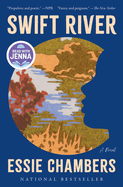
Essie Chambers's first novel, building upon her work in film and television (the documentary Descendant), is set in the decaying New England mill town of Swift River, with meditations on place and the effect of a hometown upon generations of lives. Sixteen-year-old Diamond narrates: "This isn't a mystery or a legend. It's a story about leaving. It starts with my body. My body is a map of the world." Her voice is strong, clear, and confident, interspersed with flashbacks to Diamond's life at age nine, when her father disappeared. These two timelines are eventually joined by letters from a previously unknown aunt and great-aunt, so that the voices of three women over decades triangulate a story of longing, family connections, and growing into oneself.
In the summer of 1987, Diamond mourns her lost father, the lone man of color in town, as she and her mother, of "pure Irish stock," struggle with ostracization and social class. Out of the blue, a letter from an Aunt Lena in Woodville, Ga., disrupts Diamond's sense of herself and her heritage, and establishes her first link to any family since her beloved Pop disappeared. From Diamond and Lena's exchange of letters surface the preserved letters of Lena's Aunt Clara, so that three versions of Swift River slowly emerge through the years.
Swift River is an ambitious novel. Chambers's choice of the epistolary format is inspired, as Lena's and Clara's voices emphasize the importance of relationships and connection. Featuring strong characters and a strong sense of place, amid numerous social issues and personal challenges, Chambers's novel will appeal to a wide audience and stick with its readers long past its stirring final pages. --Julia Kastner

